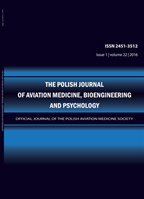2018, Volume 24, Issue 2
MASS CASUALTIES TRIAGE ALGORITHM WITH THE USE OF StO2 LEVELS, HR AND BODY TEMPERATURE MEASUREMENTS
LECH KOPKA1, EWELINA ZAWADZKA-BARTCZAK2, KRZYSZTOF KOWALCZUK3, MARCIN PIOTROWSKI3, MARIUSZ KREJ4
-------------------------------------------------------------------------------------------------
1Centre of Experimental Medicine, Military Institute of Aviation Medicine
2Department of Internal Disease, Military Institute of Aviation Medicine
3Department of Simulator Studies and Aeromedical Training, Military Institute of Aviation Medicine
4Department of Flight Simulator Innovations, Military Institute of Aviation Medicine
Autor korenspondencyjny: LECH KOPKA; Centre of Experimental Medicine, Military Institute of Aviation Medicine; email: lkopka@wiml.waw.pl
Full text
Streszczenie
Objectives: The paper presents the advantages and disadvantages of the current mass events victim care system with use of the START (simple triage and rapid treatment) procedure and the usefulness of the StO2, HR and body temperature measurements, which are communicated via the newly created communication system to the rescue personnel. The aims of this procedure were:
- Providing answers to the following:
- Is there a correlation between StO2 values and the associated heart rate changes (Δ HR)?
- Are the values of StO2 and HR measured at ambient temperatures ranging from -15 to +40 degrees using the pulse oximeter reliable and reproducible?
- What values of StO2, HR and body temperature of the victim may be a basis for secondary evacuation (yellow band) of the victim, and at what point immediate evacuation (red band) is required?
- Development of a medical segregation algorithm for use in mass operations, taking into account the values of StO2, HR and body temperature of the injured.
Methods: The purpose of the study was to determine the needs for triage, is there a correlation between StO2 values and associated HR values, determined in hypoxia. All of the subjects were evaluated for HR changes (ΔHR) associated with gradually decreasing St02 values, which were determined by near-infrared spectroscopy (NIRS).
Also, if StO2 levels, HR and body temperature measurements are reliable in temperatures in the range of -15 to +40 degrees. Lastly, a modified medical segregation algorithm for the injured was developed, taking into account the results of the conducted research.
The test material was obtained from 100 pilots during training in the hypobaric chamber, under normobaric hypoxia conditions (when breathing in a low-oxygen gas mixture), and results from the thermal chamber examinations.
Results: The studies have shown that as the StO2 decreases to about 85%, there is an increase in the heart rate. After that, in most of the subjects, it slows down without a transitional phase of oscillations or plateau rhythm. StO2 levels ranging from 95% to 85% showed an average, significant relationship with HR -r = -0.361; p <0.001. In the StO2 ranging from 84% to 70%, a significant but weak negative correlation with HR was found - r = -0.231; p <0.001.
Conclusions: Based on the results of the research and theoretical considerations, a validated triage algorithm was proposed.
Słowa kluczowe
vital signals, simple triage, rapid treatment evacuation
